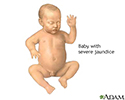Newborn jaundice - what to ask your doctor
Jaundice - what to ask your doctor; What to ask your doctor about newborn jaundiceNewborn jaundice is a common condition. It is caused by high levels of bilirubin (a yellow coloring) in your child's blood. This can make your child's skin and sclera (the whites of their eyes) look yellow. Your child may go home with some jaundice or may develop jaundice after going home.
Newborn jaundice
Newborn jaundice occurs when a baby has a high level of bilirubin in the blood. Bilirubin is a yellow substance that the body creates when it replac...

Below are some questions you may want to ask your health care provider about your child's jaundice.
Questions
- What causes jaundice in a newborn child?
- How common is newborn jaundice?
- Will the jaundice harm my child?
- What are the treatments for jaundice?
- How long does it take for the jaundice to go away?
- How can I tell if the jaundice is getting worse?
- How often should I feed my child?
- What should I do if I am having trouble breastfeeding?
- Does my child need blood transfusions for the jaundice?
- Does my child need light therapy for the jaundice? Can this be done at home?
- How do I arrange to have light therapy at home? Who do I call if I am having problems with the light therapy?
- Do I need to use light therapy all day and night? How about when I am holding or feeding my child?
- Can the light therapy harm my child?
- When do we need to have a follow-up visit with my child's provider?
References
Kaplan M, Wong RJ, Bensen R, Sibley E, Stevenson DK. Neonatal jaundice and liver disease. In: Martin RJ, Fanaroff AA, eds. Fanaroff and Martin's Neonatal-Perinatal Medicine. 12th ed. Philadelphia, PA: Elsevier; 2025:chap 95.
Kliegman RM. Digestive system disorders. In: Kliegman RM, St. Geme JW, Blum NJ, et al, eds. Nelson Textbook of Pediatrics. 22nd ed. Philadelphia, PA: Elsevier; 2025:chap 134.
Rozance PJ, Wright CJ. The neonate. In: Landon MB, Galan HL, Jauniaux ERM, et al, eds. Gabbe's Obstetrics: Normal and Problem Pregnancies. 9th ed. Philadelphia, PA: Elsevier; 2025:chap 25.
Infant jaundice - illustration
Jaundice is a yellow discoloring of the skin, mucous membranes, and eyes, caused by too much bilirubin (a breakdown product of hemoglobin made by the liver) in the blood. Jaundice is a condition produced when excess amounts of bilirubin circulating in the blood stream dissolve in the subcutaneous fat (the layer of fat just beneath the skin), causing a yellowish appearance of the skin and the whites of the eyes.
Infant jaundice
illustration
Infant jaundice - illustration
Jaundice is a yellow discoloring of the skin, mucous membranes, and eyes, caused by too much bilirubin (a breakdown product of hemoglobin made by the liver) in the blood. Jaundice is a condition produced when excess amounts of bilirubin circulating in the blood stream dissolve in the subcutaneous fat (the layer of fat just beneath the skin), causing a yellowish appearance of the skin and the whites of the eyes.
Infant jaundice
illustration
- Depression - InDepth(In-Depth)
Review Date: 1/17/2025
Reviewed By: Charles I. Schwartz, MD, FAAP, Clinical Assistant Professor of Pediatrics, Perelman School of Medicine at the University of Pennsylvania, General Pediatrician at PennCare for Kids, Phoenixville, PA. Also reviewed by David C. Dugdale, MD, Medical Director, Brenda Conaway, Editorial Director, and the A.D.A.M. Editorial team.


